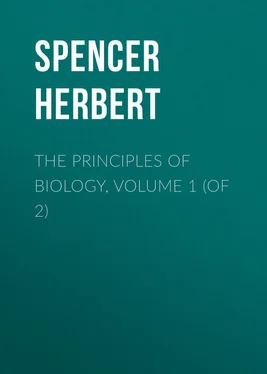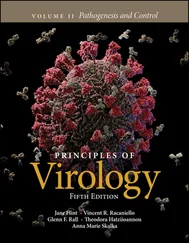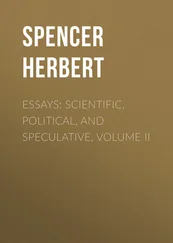Herbert Spencer - The Principles of Biology, Volume 1 (of 2)
Здесь есть возможность читать онлайн «Herbert Spencer - The Principles of Biology, Volume 1 (of 2)» — ознакомительный отрывок электронной книги совершенно бесплатно, а после прочтения отрывка купить полную версию. В некоторых случаях можно слушать аудио, скачать через торрент в формате fb2 и присутствует краткое содержание. Жанр: Философия, foreign_antique, foreign_prose, на английском языке. Описание произведения, (предисловие) а так же отзывы посетителей доступны на портале библиотеки ЛибКат.
- Название:The Principles of Biology, Volume 1 (of 2)
- Автор:
- Жанр:
- Год:неизвестен
- ISBN:нет данных
- Рейтинг книги:3 / 5. Голосов: 1
-
Избранное:Добавить в избранное
- Отзывы:
-
Ваша оценка:
- 60
- 1
- 2
- 3
- 4
- 5
The Principles of Biology, Volume 1 (of 2): краткое содержание, описание и аннотация
Предлагаем к чтению аннотацию, описание, краткое содержание или предисловие (зависит от того, что написал сам автор книги «The Principles of Biology, Volume 1 (of 2)»). Если вы не нашли необходимую информацию о книге — напишите в комментариях, мы постараемся отыскать её.
The Principles of Biology, Volume 1 (of 2) — читать онлайн ознакомительный отрывок
Ниже представлен текст книги, разбитый по страницам. Система сохранения места последней прочитанной страницы, позволяет с удобством читать онлайн бесплатно книгу «The Principles of Biology, Volume 1 (of 2)», без необходимости каждый раз заново искать на чём Вы остановились. Поставьте закладку, и сможете в любой момент перейти на страницу, на которой закончили чтение.
Интервал:
Закладка:
Throughout the vegetal kingdom, the illustrations of this truth are not conspicuous and regular: the obvious reason being that since plants are accumulators and in so small a degree expenders, the premises of the above argument are but very partially fulfilled. The food of plants (excepting Fungi and certain parasites) being in great measure the same for all, and bathing all so that it can be absorbed without effort, their vital processes result almost entirely in profit. Once fairly rooted in a fit place, a plant may thus from the outset add a very large proportion of its entire returns to capital; and may soon be able to carry on its processes on a large scale, though it does not at first do so. When, however, plants are expenders, namely, during their germination and first stages of growth, their degrees of growth are determined by their amounts of vital capital. It is because the young tree commences life with a ready-formed embryo and store of food sufficient to last for some time, that it is enabled to strike root and lift its head above the surrounding herbage. Throughout the animal kingdom, however, the necessity of this relation is everywhere obvious. The small carnivore preying on small herbivores, can increase in size only by small increments: its organization unfitting it to digest larger creatures, even if it can kill them, it cannot profit by amounts of nutriment exceeding a narrow limit; and its possible increments of growth being small to set out with, and rapidly decreasing, must come to an end before any considerable size is attained. Manifestly the young lion, born of tolerable bulk, suckled until much bigger, and fed until half-grown, is enabled by the power and organization which he thus gets gratis , to catch and kill animals big enough to give him the supply of nutriment needed to meet his large expenditure and yet leave a large surplus for growth. Thus, then, is explained the above-named contrast between the ox and the sheep. A calf and a lamb commence their physiological transactions on widely different scales; their first increments of growth are similarly contrasted in their amounts; and the two diminishing series of such increments end at similarly-contrasted limits.
§ 49. Such are the several conditions by which the phenomena of growth are determined. Conspiring and conflicting in endless unlike ways and degrees, they in every case qualify more or less differently each other's effects. Hence it happens that we are obliged to state each generalization as true on the average, or to make the proviso – other things equal.
Understood in this qualified form, our conclusions are these. First, that growth being an integration with the organism of such environing matters as are of like natures with the matters composing the organism, its growth is dependent on the available supply of them. Second, that the available supply of assimilable matter being the same, and other conditions not dissimilar, the degree of growth varies according to the surplus of nutrition over expenditure – a generalization which is illustrated in some of the broader contrasts between different divisions of organisms. Third, that in the same organism the surplus of nutrition over expenditure differs at different stages; and that growth is unlimited or has a definite limit, according as the surplus does or does not rapidly decrease. This proposition we found exemplified by the almost unceasing growth of organisms that expend relatively little energy; and by the definitely limited growth of organisms that expend much energy. Fourth, that among organisms which are large expenders of force, the size ultimately attained is, other things equal, determined by the initial size: in proof of which conclusion we have abundant facts, as well as the a priori necessity that the sum-totals of analogous diminishing series, must depend upon the amounts of their initial terms. Fifth, that where the likeness of other circumstances permits a comparison, the possible extent of growth depends on the degree of organization; an inference testified to by the larger forms among the various divisions and sub-divisions of organisms.
CHAPTER II.
DEVELOPMENT. 19
§ 50. Certain general aspects of Development may be studied apart from any examination of internal structures. These fundamental contrasts between the modes of arrangement of parts, originating, as they do, the leading external distinctions among the various forms of organization, will be best dealt with at the outset. If all organisms have arisen by Evolution, it is of course not to be expected that such several modes of development can be absolutely demarcated: we are sure to find them united by transitional modes. But premising that a classification of modes can but approximately represent the facts, we shall find our general conceptions of Development aided by one.
Development is primarily central . All organic forms of which the entire history is known, set out with a symmetrical arrangement of parts round a centre. In organisms of the lowest grade no other mode of arrangement is ever definitely established; and in the highest organisms central development, though subordinate to another mode of development, continues to be habitually shown in the changes of minute structure. Let us glance at these propositions in the concrete. Practically every plant and every animal in its earliest stage is a portion of protoplasm, in the great majority of cases approximately spherical but sometimes elongated, containing a rounded body consisting of specially modified protoplasm, which is called a nucleus; and the first changes that occur in the germ thus constituted, are changes that take place in this nucleus, followed by changes round the centres produced by division of this original centre. From this type of structure, the simplest organisms do not depart; or depart in no definite or conspicuous ways. Among plants, many of the simplest Algæ and Fungi permanently maintain such a central distribution; while among animals it is permanently maintained by creatures like the Gregarina , and in a different manner by the Amœba , Actinophrys , and their allies: the irregularities which are many and great do not destroy this general relation of parts. In larger organisms, made up chiefly of units that are analogous to these simplest organisms, the formation of units ever continues to take place round nuclei; though usually the nuclei soon cease to be centrally placed.
Central development may be distinguished into unicentral and multicentral ; according as the product of the original germ develops more or less symmetrically round one centre, or develops without subordination to one centre – develops, that is, in subordination to many centres. Unicentral development, as displayed not in the formation of single cells but in the formation of aggregates, is not common. The animal kingdom shows it only in some of the small group of colonial Radiolaria . It is feebly represented in the vegetal kingdom by a few members of the Volvocineæ . On the other hand, multicentral development, or development round insubordinate centres, is variously exemplified in both divisions of the organic world. It is exemplified in two distinct ways, according as the insubordination among the centres of development is partial or total. We may most conveniently consider it under the heads hence arising.
Total insubordination among the centres of development, is shown where the units or cells, as fast as they are severally formed, part company and lead independent lives. This, in the vegetal kingdom, habitually occurs among the Protophyta , and in the animal kingdom, among the Protozoa . Partial insubordination is seen in those somewhat advanced organisms, that consist of units which, though they have not separated, have so little mutual dependence that the aggregate they form is irregular. Among plants, the Thallophytes very generally exemplify this mode of development. Lichens, spreading with flat or corrugated edges in this or that direction as the conditions determine, have no manifest co-ordination of parts. In the Algæ the Nostocs and various other forms similarly show us an unsymmetrical structure. Of Fungi we may say that creeping kinds display no further dependence of one part on another than is implied by their cohesion. And even in such better-organized plants as the Marchantia , the general arrangement shows no reference to a directive centre. Among animals many of the Sponges in their adult forms may be cited as devoid of that co-ordination implied by symmetry: the units composing them, though they have some subordination to local centres, have no subordination to a general centre. To distinguish that kind of development in which the whole product of a germ coheres in one mass, from that kind of development in which it does not, Professor Huxley has introduced the words " continuous " and " discontinuous ;" and these seem the best fitted for the purpose. Multicentral development, then, is divisible into continuous and discontinuous.
Читать дальшеИнтервал:
Закладка:
Похожие книги на «The Principles of Biology, Volume 1 (of 2)»
Представляем Вашему вниманию похожие книги на «The Principles of Biology, Volume 1 (of 2)» списком для выбора. Мы отобрали схожую по названию и смыслу литературу в надежде предоставить читателям больше вариантов отыскать новые, интересные, ещё непрочитанные произведения.
Обсуждение, отзывы о книге «The Principles of Biology, Volume 1 (of 2)» и просто собственные мнения читателей. Оставьте ваши комментарии, напишите, что Вы думаете о произведении, его смысле или главных героях. Укажите что конкретно понравилось, а что нет, и почему Вы так считаете.












